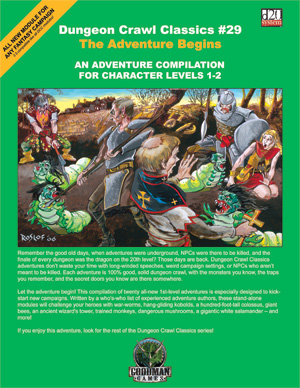Day number two of this year's (eight-day)
Strategy Games Summer Camp presented me with a cool opportunity: the chance to demo my very own home-brew fantasy role-playing game "
Olde School Wizardry" to an entirely new audience.

I had six players, grades 6-8, five boys and one girl, with a mix of experienced role-players and complete novices who had never rolled a D20 before.
As each player rolled up a novice wizard, character creation moved pretty quickly. The players picked from Magical Sciences as diverse as
Iron, Cheese, Goblins, and Pebbles, and they divided up their points of "Lore" between various magical Runes ... the verbs that define the action of any given spell.
For a scenario I wanted something quick, but with a bit of memorable panache to it, so I turned to
Dungeon Crawl Classics -- DCC is basically a light version of 3rd Edition D&D with some additional gonzo charts thrown in for spell resolution and such. I've been doing this long enough that honestly I didn't so much as read a single critter stat block, but just skimmed the text ("3 pirates" ... got it; "3 ivory statues that animate when messed with" check.

The basic plot is that there is a submerged wizard tower that can only be reached for a few hours once every so many years ... so the characters have to act fast if they want to loot the place and get back out before sea water drowns the tower again.
Toss in a wild magic candle room, a puzzle with some magic portals, a few light weight traps, a competing crew of adventurers and the inevitable ubber-trapped treasure and you've got a solid little setting to play with.
I was concerned that the complexity level might be a little high, my unique magic system a little fiddly, or the entire game a bit loose and conceptual for concrete-thinking middle schoolers, but it turns out I needn't have worried!
They took to it like fish to water and soon, to my delight, they were shaping spells in incredibly creative ways to solve the problems presented by the dungeon. Here are some examples from their three-hour session:
- Q: How to get from the swaying deck of the ship to the top of the partially submerged tower?
- A: Create a floating causeway of Doors, Enchanted to stick together.
- Q: How to check for traps and other dangers in the wizard tower?
- A: Create a squad of over-sized, "Obedient Goblins" with extra hit points and send them into the gloom ahead of the group.
- Q: How to bridge the gap in the ancient, rotten wooden staircase?
- A: Restore the Wood to repair the damage.
- Q: How to find and replace the magical gemstone eyes in the statue to reactivate the magic portal?
- A: Don't bother! Just magically reshape the chestnuts carried by the wizard with Plant Science into the exact shape required and bingo!
- Q: How to cross the flooded chamber writhing with thousands of eyeless, black venom-eels?
- A: Destroy Flesh in the chamber, adding the magical Formula specifying "while submerged" to ensure that only eel Flesh got disintegrated.
Not to make any of this sound easy of course! There were as many blunders and gaffs as there were successes. At one point a wizard went to great lengths to Create a chunk of Iron to use as an improvised weapon, completely forgetting that he had already picked up a cutlass that was discarded when the goblins ate a gang of pirates. Exhausting their Quintessence (mana), several wizards pushed ahead with their casting anyway ... substituting their hit points and incurring strange side effects from the resulting "Spell Burn." One excited fellow just kept Creating Doors over and over, seldom pausing to work out just how having extra Doors laying about would help in the situation.
Some things I learned about my own system from this session:
1. When playing with anyone who can't legally drive, I should use tokens to help them keep track of their Quintessence. Fortunately I figured this out about 30 seconds into scene one and had tons of tokens on hand.


2. Most middle schoolers are profligate spenders. Give em 10 Quintessence tokens and they'll bloody well spend ten at the first opportunity. At one point in our game a young fellow began to work complex magics to reshape and remove the protective Plant wall that had sheltered the explorers during a rest ... never mind that by now three of them had cutlasses which could do the trick without the risk of making their brains catch fire.
3. In Olde School Wizardry each of the six character stats (rolled on a 3-18 scale) really matters and has an important part to play. My daughter rolled up a character, Cheese wizard Appleroy Orf, who had a dismal Dexterity of 5. This meant that, round after round, she was always the last to take her action. But rather than let this be an obstacle to getting things done, she worked out how to specialize in high Quintessence-cost Formulae that none of her companions had the ability to cast. This means that while she generally couldn't decide what magical verb (Rune) was put into play (Create, Destroy, Transmute, etc.) or even what Magical Science it was linked to, she could get in the last word about how much of a given Science was affected or how long the spell lasted. In short, everyone had a part and everyone was needed!

The system worked like a six-person Wonder Twins / Voltron Robot Lion / Power Zord ... just as I had hoped it would.








.jpg)












